| Section 8 | ICT Seminar and AGM 7th March 2023 |
|
|
Widely believed to be the traditional Centre of England, Meriden was a popular venue for a gathering of the UK printed circuit community this month. They braved the forecast of heavy snow for the Institute of Circuit Technology’s annual general meeting to learn about current developments and challenges in a thought-provoking technical seminar and to network with industry peers and contemporaries. Thankfully, the forecasted heavy snowfall did not reach Meriden until after the event; we only had a few flurries, although the weather caused considerable disruption elsewhere in the country. After the formal business of the annual general meeting had been efficiently managed and conducted by ICT Chair Emma Hudson, the early highlight of the evening session was the award of Honorary Fellowship to Rex Rozario OBE. He is credited with being part of the team that developed the first circuit board in England in the 1950s. |
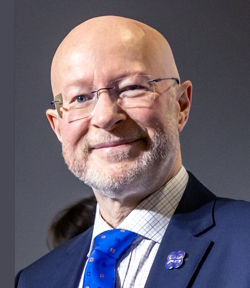 Alun Morgan Alun Morgan |
The State of Energy The increasing availability of energy has transformed the course of humanity, he said, and the quantity consumed and produced has inevitably continued to increase. Fossil fuels have been supplemented with new energy sources: hydropower, nuclear and more recently with renewable technologies. Although decarbonisation is progressing slowly, it is essential that fossil fuels be displaced in the energy mix at a much faster rate. His charts of global energy consumption and energy production by fuel type illustrated the wide gap that exist between: Groups of principal sources: oil, coal, and gas Morgan then focused on the PCB industry, reviewing world trends and concluding with Europe’s position. Whereas world PCB production has grown from $33.1 billion in 2000 to $60.8 billion in 2019, Europe’s share has reduced from $5.4 billion to $1.9 billion during the same period. But although the number of manufacturers has shrunk from 550 to 173, revenues have remained relatively stable since 2010. The European PCB industry is losing ground due to raw materials and equipment being increasingly difficult to source in Europe, reduced investment capital compared with other regions, and reduced availability of technical resources and workforce. The relative stability of the industry is closely related to its areas of specialisation: strong defence and aeronautics sectors, strong medical sector, and other specialised areas. Presently, the top 30 companies made 70% of the volume in Europe. But the industry was heavily dependent on its supply chain and needed to maintain its critical mass to secure supply continuity. Returning to Morgan’s primary topic, the unique competitive disadvantage Europe suffers relative to its competitors is the cost of energy. In 2021, even before Russia invaded Ukraine, the average price of electricity in U.S. dollars per kilowatt hour was $0.323 in Germany compared with $0.109 in the U.S. and $0.084 in China. In seeking government support, current employment numbers in the PCB industry are not large enough to have meaningful political significance, but defence and security considerations certainly are—a stable European supply base is considered essential—and it is from this perspective that government is being approached. |
|
|
A Focus on Assistive Device Technology A key component of the process is an ink-jettable copper-silver core shell catalyst. This is an alternative to palladium which, although an excellent catalyst, was very expensive and classified as a “critical raw material.” Pure copper nanoparticle colloids are not stable and tend to aggregate over time. Using polyacrylic acid as a shell-ligand produces a stable colloid which enables a uniform electroless copper deposit, but the long-term stability of the ink needs improvement. Adding silver nitrate to a copper nanoparticle/polyacrylic acid dispersion results in an exchange reaction, creating a silver-core shell colloid. This is formulated into an ink-jet printable catalyst, and the silver shell significantly increased the lifetime of the ink. Printed onto a polyester fabric, this ink enables selective metallisation with electroless copper and increasing the number of print cycles increases the copper mass gain. It has been observed that the resistance of the copper deposit decreases with increasing print cycles, there is some difference between warp and weft directions, and resistance increases after each washing cycle. Professor Cobley showed examples of Maturolife prototypes incorporated into assistive footwear, designed to help in the understanding of gait and balance. |
|
|
Things to Consider When It Comes to Thermals He began by reviewing the nature and basic construction of insulated metal substrates and their important datasheet parameters: thermal resistor, thermal impedance, thermal conductivity, glass transition temperature, maximal operating temperature, breakdown voltage and hi-pot withstand. The first and most important datasheet value he considered was thermal resistor or thermal impedance, denoted Rth or Zth, which was measured directly and from which thermal conductivity was calculated. Different test methods gave different values; in the example he used, ISO 22007-2 gave 5W/mK, ASTM E1461 gave 3.3W/mK, ASTM D5470 gave 3.0W/mK, and Bruggeman Modelling gave 12W/mK. Art commented that the ASTM D5470 test was most commonly used; it gave the lowest value because it measured the complete stackup, including the losses in the transfer areas. “Don’t accept thermal conductivity values,” he advised, and demonstrated the sizeable tolerance bands associated with different test methods, implying that a low-cost competitor can quote almost any value and still be in tolerance, depending on the method. Art commented that Ventec is a member of an IPC working group that includes other suppliers and ZFR (Zentrum fuer Waermemanagement) in Stuttgart, to improve the accuracy of the measurement method by tightening thickness tolerances and clearly defining test parameters and probe locations. He asked, “When should you take a deeper look to the datasheet?” and then listed some key points. These include checking which test method has been used for dielectrics with claimed thermal conductivity of 4W/mK and higher, checking in detail how Rth has been measured, and with what tolerance. For values below 0.4, it’s checking the dielectric thickness that has been used as a probe for an ASTM test, questioning why different thermal measurement methods have been used for closely related values quoted on the datasheet in order to improve their appearance, and being suspicious of remarks like “modified” in reference to test methods. Having briefly discussed maximal operating temperature, breakdown voltage and hi-pot withstand, Art mentioned the significance of glass transition temperature in IMS dielectrics compared with rigid laminates, where a lower Tg gave a more resilient product and in combination with a low-expansion aluminium alloy helped to mitigate solder joint cracking. But his over-riding message in specifying an IMS material was, “Be careful, and make sure you understand how it is measured.” |
|
|
Chemical Legislation and Restrictions on Solder Masks The final presentation of the seminar came from Chris Wall, technical director of Electra Polymers, who succeeded in making the subject of chemical legislation and restrictions on solder masks both interesting and enlightening. He explained that the European Union REACH regulation (Registration, Evaluation, Authorisation, and Restriction of Chemicals), which originally came into force in 2007, requires manufacturers and importers of chemicals to register the substances they produce or place on the market in Europe with the European Chemicals Agency (ECHA). The REACH regulation establishes a process for identifying and controlling substances of very high concern (SVHCs). When the UK withdrew from the European Union, the UK government created UK REACH, which adopted all the provisions of REACH (as they were BREXIT at the time) and regulates chemicals placed on the market in the UK. The UK REACH and the EU REACH regulations operate independently of each other and suppliers must ensure that they comply with both regulations where necessary. Clearly, this raises potential issues for global suppliers. Wall pointed out that, currently, the specific relevance to solder mask formulation is to the widely-used photoinitiators “907” (2-methyl-1-(4-methylthiophenyl)-2-morpholinopropan-1-one) and “369” (2-benzyl-2-dimethylamino-4'-morpholinobutyrophenone). Both materials have recently been prioritised for inclusion in the Authorisation List of substances that can only be used under specific conditions, such that the risks are adequately controlled. Certain other components of solder masks are subject to, or likely to become subject to, usage restrictions. The timeline for photoinitiators “907” and “369” is an Authorisation Period of 18, 21, or 24 months from the date of inclusion in the Authorisation List, for manufacturers or importers to apply for authorisation to continue manufacture of import of the material. If this is granted, it will be authorised for use for a further period of time. At the same time, a “Sunset Date” will be notified, which is 18 months after the “Latest Application Date. After the “Sunset Date,” the substance can no longer be used or placed on the market without an authorisation. Wall’s presentation raised many questions from the audience, to which he responded reassuringly, stressing that there is no immediate need to panic, and that Electra and its counterparts in the industry have been working hard to develop liquid photoimageable solder mask formulations of equivalent performance which do not contain the “907” or “369” ingredients. |
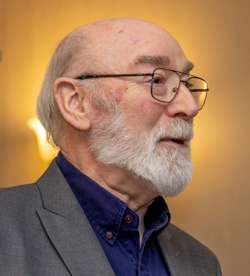 Bill Wilkie Bill Wilkie |
Bill Wilkie brought the formal proceedings to a close, with warm thanks to all who braved the weather forecast to participate, and wished everyone a safe journey home through the snow. Note: Much thanks to Alun Morgan for the beautiful images. |
| Go back to Contents |

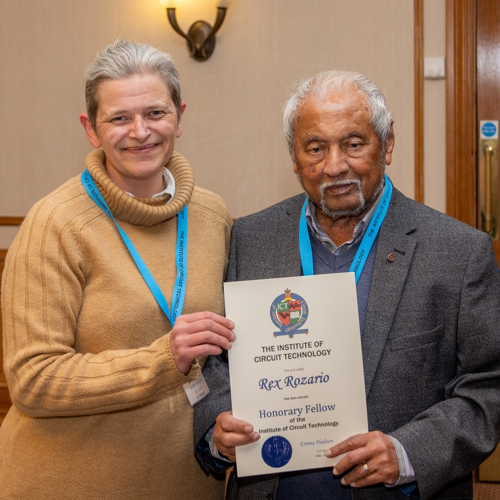 Rex Rozario
Rex Rozario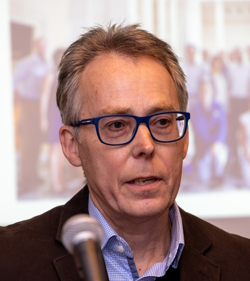 Andy Cobley
Andy Cobley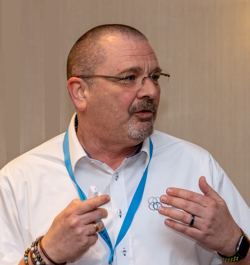 Robert Art
Robert Art 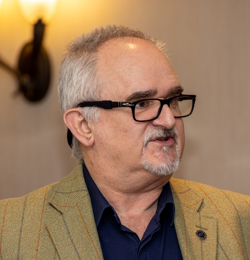 Chris Wall
Chris Wall